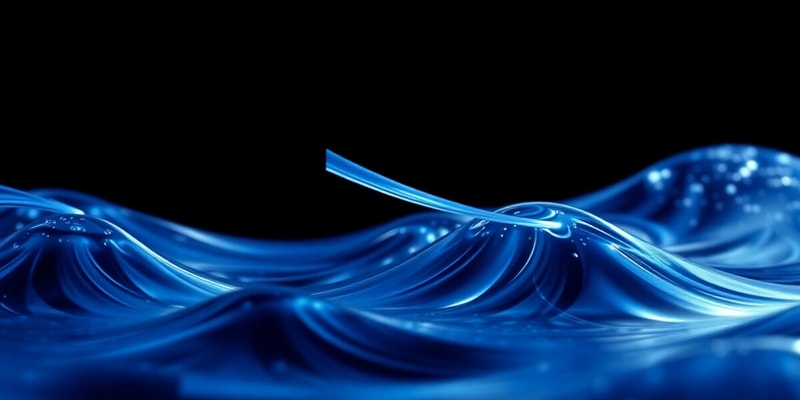Podcast
Questions and Answers
What is plotted on the y-axis of a displacement-distance graph?
What is plotted on the y-axis of a displacement-distance graph?
Which phenomenon causes waves to change direction when entering shallow water?
Which phenomenon causes waves to change direction when entering shallow water?
What remains constant during the reflection of waves?
What remains constant during the reflection of waves?
What is the amplitude of the wave described in the displacement-time graph?
What is the amplitude of the wave described in the displacement-time graph?
Signup and view all the answers
Which of the following statements about frequency during refraction is true?
Which of the following statements about frequency during refraction is true?
Signup and view all the answers
Which of the following best describes diffraction?
Which of the following best describes diffraction?
Signup and view all the answers
If the period of the wave is 0.5 seconds, what is its frequency?
If the period of the wave is 0.5 seconds, what is its frequency?
Signup and view all the answers
In a ripple tank experiment, what happens to the wavelength as the depth of water decreases?
In a ripple tank experiment, what happens to the wavelength as the depth of water decreases?
Signup and view all the answers
Study Notes
Graphical Representation of Waves
- Displacement-distance graphs show particle displacement at a specific time, plotting displacement (y-axis) against distance (x-axis); arrows indicate vibrating particle direction.
- Amplitude (0.6 cm) and wavelength (5 m) can be derived from the graph.
- Displacement-time graphs show particle displacement over time at a specific point, plotting displacement (y-axis) against time (x-axis).
- Amplitude and period (0.5 s) can be seen from the graph, and frequency (2 Hz) can be calculated.
Reflection, Refraction, and Diffraction of Waves
- Waves can exhibit reflection, refraction, and diffraction.
- Ripple tanks are commonly used to demonstrate these wave properties.
- A wavefront is a surface connecting points of the same phase in a wave.
- Reflection: Waves striking an obstacle are turned back; incident angle equals reflection angle. Wavelength and velocity remain constant.
- Refraction: The speed of water waves changes with water depth. Deeper water = faster waves. Wave speed and wavelength change upon changing depth; frequency remains constant.
- Diffraction: Spreading of waves as they pass through an opening or go around an obstacle. Wider gaps result in less spreading; narrower gaps result in more spreading. Wavelength is unaffected by diffraction.
Reviewed Exercise
- Refraction of water waves is caused by changes in water depth affecting wave speed.
- Speed of water waves is influenced by water depth; deeper water = faster waves.
Studying That Suits You
Use AI to generate personalized quizzes and flashcards to suit your learning preferences.
Related Documents
Description
Test your knowledge on the graphical representation of waves and their properties. This quiz covers concepts such as displacement-distance graphs, reflection, refraction, and diffraction. Challenge yourself with questions on amplitude, wavelength, and frequency calculations.




